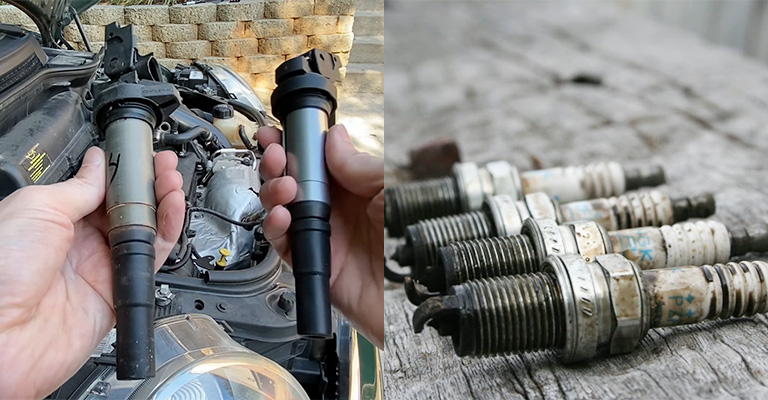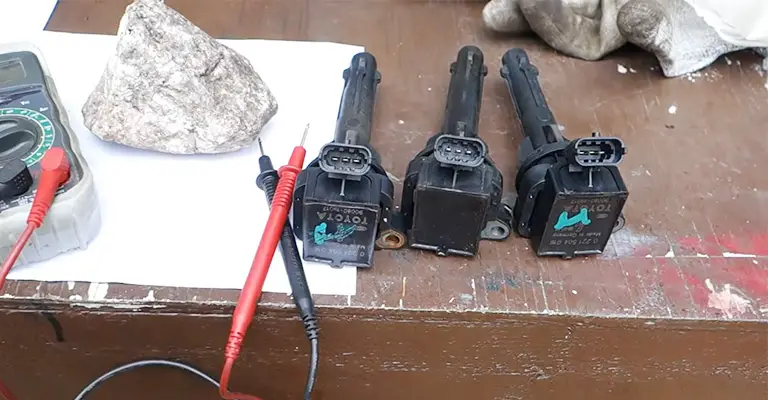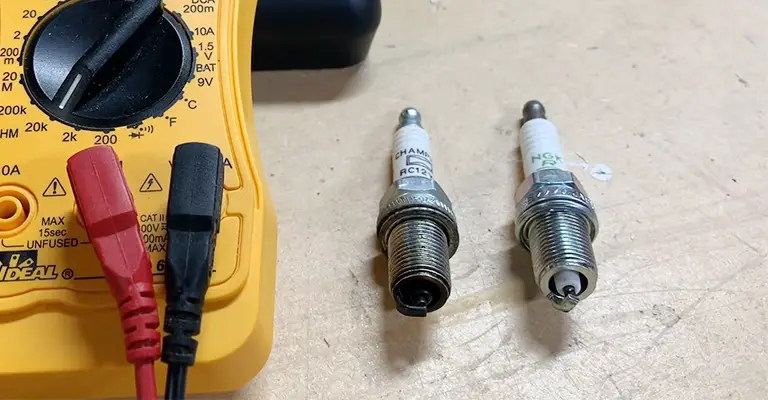The ignition coil converts low voltage into high enough voltage to help create an electrical spark. That spark is generated in a spark plug to ignite the fuel and start the engine. In other words, these two components are closely related.
Often the misconception regarding ignition coil and spark plug remains that they are the same part or they serve the same purpose. However, that is incorrect. The ignition coil supplies power whereas the spark plug creates the spark to start fuel combustion.

Ignition Coil vs Spark Plug: What Are The Differences Between Them
It is not rare to find people who think that spark plugs and ignition coils are the same. However, they are completely different. In short, the ignition coils work to transmit voltage to spark plugs to assist in the creation of a spark.
It is that spark that leads to the ignition of the vehicle. A single ignition coil powers one or two spark plugs. This is why typically, you will see one ignition coil for each cylinder in a vehicle. Understanding these two components and how they function will help you identify problems associated with them more easily.
What Does an Ignition Coil Do

An ignition coil is an induction coil you will see in your car’s ignition system. Interestingly enough, it is designed with an inner and an outer coil that helps the spark plugs create a spark. In other words, these two components are very closely related.
The ignition coil transforms the low voltage of the car’s battery into high enough voltage to create the electric spark in the spark plugs which ignites the fuel. We are talking about thousands of volts here.
Upon using the key to start the vehicle, the primary ignition system is activated which completes the circuit between the battery and coil. This creates a magnetic field result. Soon after that, the secondary ignition is triggered and creates an electrical current between the inner and the outer coils.
As a result, the battery’s 12 volts are converted into 50,000+ volts. Ignition coils are relatively small parts of the system. However, they are guaranteed to provide reliability due to their precise specifications maintained during design.
What Does a Spark Plug Do

The spark plug’s function is to supply electricity or a spark that ignites the air-fuel mixture in the car’s engine. In other words, a spark plug kicks off the combustion process and helps you start the car by utilizing the 50,000+ volts created by the ignition coil.
Upon receiving the power, a strong electrical current is generated which jumps across the spark plug’s electrode gap and produces a spark. Aside from setting the pistons into motion, a spark plug also keeps the vehicle moving down the road.
Ignition Coil Problems Symptoms
A bad ignition coil can cause a multitude of problems. For instance, you will have difficulty starting the engine and often it will misfire. Moreover, when you accelerate, you will feel a loss of power. Issues with the ignition coil can worsen the fuel economy as well.
The problems do not end here. Your car’s exhaust will feel its effect too and backfire frequently. The emissions will increase and you will smell toxic gas emanating from the exhaust. As a sign, you will see the engine’s check light illuminating.
Signs of a Bad Spark Plug

Often it becomes fairly difficult to distinguish between a bad spark plug and a defective coil because they are interrelated. Therefore, the signs you see could be due to the failure of either component. Primarily, when a spark plug goes bad, you will find increasing difficulty to start your car.
Moreover, your will misfire and suffer a loss of fuel economy. You will also hear knocking or rattling noises whenever the car idles. The engine will become excessively loud and the check engine light will illuminate.
What Is the Difference Between Ignition Coils and Spark Plugs
The differences can be illustrated based on several aspects. They are discussed in this section.
Functions
The ignition coil from your car’s ignition system is responsible for generating the spark by transforming the battery’s low voltage into thousands of volts. The spark plug uses that high voltage to generate a spark.
Number of Parts
The ignition coil has two parts, the inner coil, and the outer coil. Both incorporate to create an electrical circuit and generate electrical current. Normally, one or two spark plugs are powered by each ignition coil.
Size and Maintenance
Typically, ignition coils are small and precise components of the engine that cannot be repaired. You must replace them entirely to get the system working again. On the other hand, stripped spark plug threads are repairable.
Spark Creation
The ignition coil does not generate the spark. Instead, it is the task of the spark plug. The plug receives 50,000+ volts. As a result, a strong electrical current is induced between the plug’s electrodes. This creates a spark that burns the air-fuel mixture.
Are Ignition Coils and Spark Plug Coils the Same
Ignition coils are also referred to as spark coils. They are fundamentally induction coils that work to generate high voltage strong enough to produce a strong electrical current in the spark plugs. These coils have an internal or external resistor wire that limits the current flowing into the coil from the battery.
A high-voltage wire from the ignition coils goes to the distributor and then connects to the spark plug wires or high-tension leads. As can be seen, these components complement each other and are closely related.
Should I Replace Ignition Coils With Spark Plugs
Normally, the most common component that is replaced along with ignition coils is the spark plugs. Whether you should replace them both at the same time depends on the situation. If the spark plugs are worn, they can cause unnecessary load on the ignition coils.
Frequently Asked Questions
How much does it cost to replace ignition coils and spark plugs?
A spark plug replacement can cost you anywhere from $40 to $350. On the other hand, ignition coils can cost from $168 to $218. Also, there is a bit of labor cost involved. These charges vary from engine to engine, so you may need to pay more in some situations.
Can a bad ignition coil damage a spark plug?
A bad or faulty ignition can cause a misfire. Therefore, there is a fair chance that it can cause damage to the related spark plug.
How often should ignition coils be replaced?
There is no specific age or mileage to replace the ignition coils. You must replace them only if they go bad. The symptoms of a bad ignition coil are that there will be cracks on the plastic and misfire often.
Conclusion
Despite being a car owner, it is not uncommon to find people that have a lot of confusion when it comes to how an engine operates. If you own a car or operate a vehicle, it is a must that you should have an idea about the different components of an engine such as the spark plug or ignition coils. That way, you will be able to identify the problems and tend to your vehicle sooner.
Leave a Reply